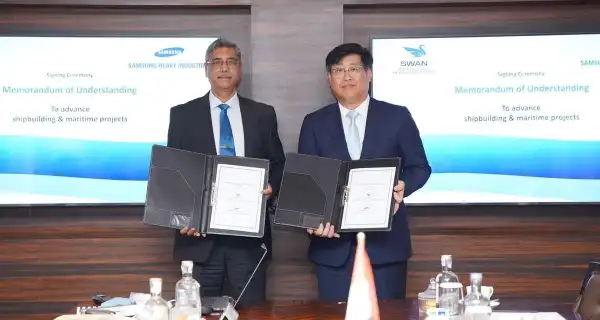Korea’s Big Bet on India: Fueling the Maritime Amrit Kaal Vision
India is charting an ambitious course to become a global maritime leader, and the world’s top shipbuilders are jumping on board. South Korea’s “Big Three” -Samsung Heavy Industries (SHI), HD Hyundai, and Hanwha Ocean—are aggressively expanding into the Indian market, signing major partnerships and leveraging technology to propel India’s shipbuilding sector into a new era of scale and quality.

The Maritime Amrit Kaal: India’s Blueprint for Global Power
The foundation for this surge of foreign interest is India’s Maritime Amrit Kaal Vision 2047, unveiled in 2023. This roadmap outlines a transformative goal: to elevate the nation’s maritime strength and become a formidable global shipbuilding power.
The key targets are clear and aggressive:
- Scale Up Production: Increase commercial ship production from roughly 1,500 vessels per year to ~2,500 annually.
- Climb Global Rankings: Break into the Top 10 global shipbuilding nations by 2030, with a long-term goal of reaching the Top 5 by 2047.
- Enhance Capability: Focus on building larger, more complex, and higher-quality vessels, including VLCCs (Very Large Crude Carriers) and advanced offshore platforms.
Strategic Alliances: Korean Tech Meets Indian Ambition
Korean firms aren’t just investing; they’re creating strategic partnerships designed for deep technological and operational transfer, ensuring India can meet its ‘Make in India’ goals.
Hanwha Ocean’s decision to establish a dedicated Global Engineering Center in India underscores the long-term commitment to utilizing the country’s engineering talent for complex, high-value component design.
Why India Is Irresistible to Global Shipbuilders
The convergence of global technical expertise and local industrial policy makes the Indian market uniquely attractive right now:
- Financial Fuel: India has established a Maritime Development Fund, committing approximately ₹25,000 crore (or billions of USD), to directly support shipbuilding projects and maritime infrastructure development.
- Massive Demand: The country’s expanding economy demands a growing fleet of commercial vessels, paired with a strategic push to localize the manufacturing of modular and specialized ships.
- Infrastructure & Location: Coastal states like Tamil Nadu, Gujarat, and Andhra Pradesh are being developed as major shipbuilding and repair hubs. Indian shipyards, like those at CSL, already possess large dry docks capable of handling major construction, an advantage magnified by foreign technical guidance.
The Road Ahead: Building from the Water Up
While the infusion of Korean technology promises a significant leap forward in fleet scale-up and job creation, the path to the 2047 vision is not without challenges. India must overcome hurdles like establishing large-vessel capacity from scratch, rapidly training a highly skilled workforce, and ensuring the supply chain can meet global quality and consistency standards.
However, with the active engagement of shipbuilding giants like Samsung, Hyundai, and Hanwha, the tide is clearly turning. The waves of Korean-Indian collaboration are expected to drive a powerful transformation, accelerating India’s journey toward its goal of becoming a global maritime powerhouse.
